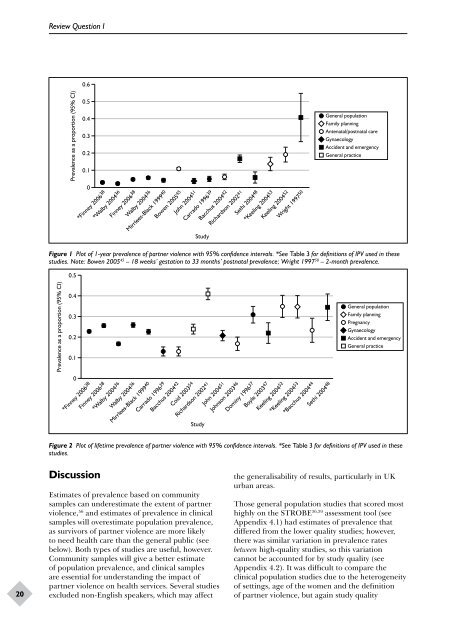How far does screening women for domestic (partner) - NIHR Health ...
How far does screening women for domestic (partner) - NIHR Health ...
How far does screening women for domestic (partner) - NIHR Health ...
You also want an ePaper? Increase the reach of your titles
YUMPU automatically turns print PDFs into web optimized ePapers that Google loves.
20<br />
Review Question I<br />
Prevalence as a proportion (95% CI)<br />
0.6<br />
0.5<br />
0.4<br />
0.3<br />
0.2<br />
0.1<br />
0<br />
*Finney 200638 *Walby 200436 Finney 2006 38<br />
Walby 200436 Mirrlees-Black 199940 Bowen 200545 John 200451 Study<br />
Carrado 199639 Bacchus 200442 Richardson 200241 Sethi 200448 *Keeling 200453 Keeling 200452 Wright 199750 General population<br />
Family planning<br />
Antenatal/postnatal care<br />
Gynaecology<br />
Accident and emergency<br />
General practice<br />
Figure 1 Plot of 1-year prevalence of <strong>partner</strong> violence with 95% confidence intervals. *See Table 3 <strong>for</strong> definitions of IPV used in these<br />
studies. Note: Bowen 2005 45 – 18 weeks’ gestation to 33 months’ postnatal prevalence; Wright 1997 50 – 2-month prevalence.<br />
Prevalence as a proportion (95% CI)<br />
0.5<br />
0.4<br />
0.3<br />
0.2<br />
0.1<br />
0<br />
*Finney 200638 Finney 200638 *Walby 200436 Walby 200436 Mirrlees-Black 199940 Carrado 199639 Bacchus 200442 Coid 200354 Richardson 200241 John 200451 Johnson 200346 Dominy 199637 Boyle 200347 Keeling 200452 *Keeling 200453 *Bacchus 200444 Sethi 200448 Study<br />
General population<br />
Family planning<br />
Pregnancy<br />
Gynaecology<br />
Accident and emergency<br />
General practice<br />
Figure 2 Plot of lifetime prevalence of <strong>partner</strong> violence with 95% confidence intervals. *See Table 3 <strong>for</strong> definitions of IPV used in these<br />
studies.<br />
Discussion<br />
Estimates of prevalence based on community<br />
samples can underestimate the extent of <strong>partner</strong><br />
violence, 56 and estimates of prevalence in clinical<br />
samples will overestimate population prevalence,<br />
as survivors of <strong>partner</strong> violence are more likely<br />
to need health care than the general public (see<br />
below). Both types of studies are useful, however.<br />
Community samples will give a better estimate<br />
of population prevalence, and clinical samples<br />
are essential <strong>for</strong> understanding the impact of<br />
<strong>partner</strong> violence on health services. Several studies<br />
excluded non-English speakers, which may affect<br />
the generalisability of results, particularly in UK<br />
urban areas.<br />
Those general population studies that scored most<br />
highly on the STROBE 36,39 assessment tool (see<br />
Appendix 4.1) had estimates of prevalence that<br />
differed from the lower quality studies; however,<br />
there was similar variation in prevalence rates<br />
between high-quality studies, so this variation<br />
cannot be accounted <strong>for</strong> by study quality (see<br />
Appendix 4.2). It was difficult to compare the<br />
clinical population studies due to the heterogeneity<br />
of settings, age of the <strong>women</strong> and the definition<br />
of <strong>partner</strong> violence, but again study quality
















